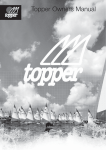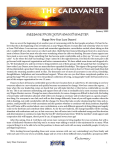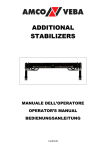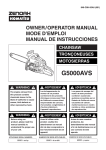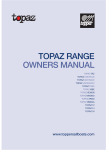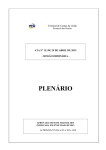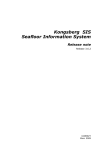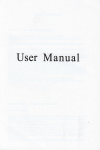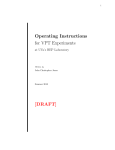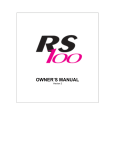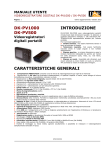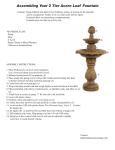Download Owners manual Topper
Transcript
Owners manual Topper 8/2/06 12:34 Page 1 Topper Owners Manual Owners manual Topper 8/2/06 12:34 Page 2 I P2. Components Each of the components of your new Topper sailing dinghy has a special name and a place. We recommend that you study the diagrams and the instructions given in the handbook before setting sail. A. B. C. D. E. F. G. H. I. J. K. L. M. N. P. Q. R. S. T. U. V. W. X. Y. K Halyard loop Kicking Strap (Boom Vang) Downhaul Mainsheet Assembly Bow Painter Outhaul Rope Horse Clew Strop Masthead Crane 2-part Aluminium Mast Topper Sail Insignia Self-Adhesive sail numbers Mainsail Aluminium Boom Daggerboard Rudder and Tiller Assembly Tiller Extension Locking Mastgate Daggerboard Casing Self Bailer Toe Strap Cord Side Toe Strap Centre Toe Strap Transom Plate L J M A C E F B N H D R G P Q Owners manual Topper 8/2/06 12:34 Page 3 S T U V W X Y The Topper is built to the One-Design of Ian Proctor under licence of the Copyright from Ian Proctor Designs Limited. Topper is a registered Trade Mark of Ian Proctor Designs Ltd. Owners manual Topper 8/2/06 12:34 Page 4 P4. Contents Your Topper The Control Lines - Identification Sail Numbers - How to apply them Preparing the mast Sleeving the sail p9. Stepping the mast Fitting the boom p10. Mainsheet & Rope Horse Downhaul and Kicking Strap p11. Rudder and Daggerboard Reefing the sail p12. The Topper Race Pack p16. Adjusting the Sail p17. Tuning for Performance p18. Car Topping p19. Care and maintenance p20. Guarantee Join the Club! - ITCA p21. ITCA membership Register of Guarantee I.B.C. Declaration of Conformity back cover Topper International contact details p5. p6-7. p8. Welcome to the Topper Class Congratulations on becoming the owner of a brand new Topper sailboat. We at Topper International believe that Topper’s advanced design and sophisticated construction process will ensure that you enjoy many years of troublefree and exciting sailing. To enhance the enjoyment of your new Topper we have arranged for new Topper owners to receive FREE membership of the Topper International Class Association for the first year of ownership. There are many benefits and full details are included in this Owner’s Manual. If you should incur any problems with your Topper, our sales staff will be pleased to offer advice and supply any spare parts and accessories you may need. Your International Topper Class Secretary will be pleased to advise you on the many aspects of Topper ownership. Owners manual Topper 8/2/06 12:34 Page 5 P5. Control lines A Centre Mainsheet and an Aft Rigged Mainsheet are available. The Aft Rigged Mainsheet kit is pictured below. The Centre Mainsheet kit is pictured on page 12. Before attempting to assemble your Topper, carefully study the diagram on the inside front cover of this handbook and thoroughly familiarise yourself with all the components, their correct names and places on the boat. If you follow these rigging instructions, stage-by-stage you will find Topper incredibly simple and quick to prepare for the water. When you have unpacked everything, lay out the various control lines on the foredeck and identify them: A. B. C. D. E. F. G. H. I. Main Halyard Loop Kicking Strap Downhaul Mainsheet Bow Painter Outhaul Traveller Daggerboard Shockcord Toe Strap Shockcord D A H B I G E F C On the following pages we have continued this coding system on the photographs so that you can immediately identify each control line. Owners manual Topper 8/2/06 12:34 Page 6 P6. Standard Topper Sail numbers and National lettering SAIL NUMBERS (please note all measurements are minimums) - Should be placed on both sides of the sail with the numbers on the starboard side being above the ones on the port side. - They should be placed two panels below the Top Hat logo. - The height of the numbers should be 230mm. - The numbers are supplied as ‘digital eights’ from which you can produce your own sail number. - The preferred style of cutting numbers from ‘digital eights’ is shown below. - There should be 45mm between each element of the complete number. - The numbers should be in a contrasting colour to the white sailcloth. STARBOARD SIDE - The upper edge of the letters should be placed 45mm from the upper seam of that panel. - They should start 45mm from the back of the sail. PORT SIDE - The upper edge of the port letters should be 45mm below the ones on the starboard side. - They should finish 45mm from the back of the sail. ATTACHING NUMBERS & LETTERS In our experience the best way to stick the numbers down is to peel away a corner, line up the letter and then attach the corner. Pull away the backing paper slowly as you push the number onto the sail. Fiddly but it works! If in doubt please ask STARBOARD SIDE - The upper edge of the numbers should be placed 45mm from the upper seam of that panel. - They should start 45mm from the back of the sail. PORT SIDE - The upper edge of the port numbers should be 45mm below the starboard side numbers. - They should finish 45mm from the back of the sail. GBR LETTERS - Should be placed on both sides of the sail with the letters on the starboard side being above the ones on the port side. - They should be placed in the panel beneath the Top Hat logo. - The height of the letters should be 230mm. - They should be pre-formed letters at least as clear as helvetica. - There should be 45mm between each element of the complete letter. - The letters should be the same colour as the sail numbers. * NOTE: TOPPER Sail Numbers are derived from digital 8 numbers. Ten digital 8 numbers are supplied, from which any number from 0-9 can be obtained. Above you will find a simple chart showing how to obtain the number you require. Owners manual Topper 8/2/06 12:34 Page 7 P7. Championship Sail numbers If in doubt please ask Before you sail your new boat for the first time, it is most important to apply the self-adhesive numbers to the sail. The sail numbers are exclusive to the boat and correspond with the serial number/sail number plate. These are always located inside the boat attached to the toe strap. Follow these instructions carefully it is not a job to be hurried. CHAMPIONSHIP NUMBERS (please note all measurements are minimums) - Should be placed on both sides of the sail with the numbers on the starboard side being above the ones on the port side. - The height of the numbers should be 230mm. - The numbers are supplied as ‘digital eights’ from which you can produce your own sail number. - The preferred style of cutting numbers from ‘digital eights’ is shown below. - The outside corners should be snipped as shown above. - There should be 45mm between each element of the complete number. - Both sets of numbers should be in the 2nd coloured panel from the bottom of the sail. - The numbers should be in a contrasting colour to the sailcloth. - Use white numbers on red/ dark blue/purple sail panels. - Use black numbers on grey/ light blue/ yellow/ orange sail panels. STARBOARD SIDE - The start of the number should be placed 45mm from the leech of the sail. - The upper edge of the number should be 45mm from the upper seam of the panel. PORT SIDE - On the port side of the sail, the upper edge of the numbers should be 45mm from the lower edge of the starboard numbers. - The end of the last number should finish 20mm from the reinforcement patch. ATTACHING NUMBERS In our experience the best way to stick the numbers down is to peel away a corner, line up the letter and then attach the corner. Pull away the backing paper slowly as you push the number onto the sail. Fiddly but it works! Snip 2/3mm off the corner of all championship numbers Panel Red Dark Blue Light Blue Grey Yellow Purple Orange Number White White Black Black Black White Black Owners manual Topper 8/2/06 12:34 Page 8 P8. Preparing the mast Preparing the mast 1. 1. Slot the two mast sections together, making sure that the slots in the upper section have properly engaged with the rivets in the lower section. sleeving the sail 1. Unfold the sail and lay it on the ground with the bottom edge of the luff sleeve adjacent to the top of the mast. 2. Insert the mast into the luff sleeve and pull the sail down the mast. If it is windy, keep your back to the wind! Sleeving the sail 2. 3. Continue until the whole sail is sleeved and the masthead has appeared through the top of the sail. 4. Use the Halyard Loop to attach the sail to the top of the mast as shown. 5. Tuck any surplus rope neatly inside the luff sleeve and insert the burgee into the special socket. 2-3. 4. A A Owners manual Topper 8/2/06 12:34 Page 9 Stepping the mast Stepping the mast 1-2 1. Point the Topper into the wind, support the mast at a 45 degree angle and engage the base of the mast into the cup under the mastgate. 2. Walk the mast forward into an upright position, ensuring that the collar is underneath the mastgate. 4. 3. 3. Pull the cord to close the gate. 4. Push the toggle in firmly to lock. Fitting the boom Fitting the boom 1. 1. Engage the gooseneck end of the boom on to the mast immediately above the collar. 2. Thread the outhaul (F) through the boom end fitting as shown, knotting the end securely. 3. Thread the inboard end of the outhaul through the kicking strap eye and then through the tube cleat on the underside of the boom. 4. Engage the outhaul and clew strop hooks in the clew cringle of the sail. Tighten and cleat the outhaul. 3. 2. F 4. F F Owners manual Topper 8/2/06 12:34 Page 10 P10. Mainsheet and traveller rope Mainsheet and traveller rope 1. G 1. Thread the traveller rope (G) through the eyes on the stern of the boat, through the loop in the rope end and down through the cleat on the aft of the bulkhead. Tie a stop knot in the end. 2. Shackle the mainsheet block on to the rope traveller, making sure that the shackle itself - and not the pin runs on the rope. 2. D 3. Attach the other mainsheet block to the boom end with the cotter pin and split ring as shown. 4. Lead the free end of the mainsheet forward and tie a stop knot in the end. 3. D 4. Downhaul and kicking strap D 1. Clip the kicking strap hook onto the webbing strop’s metal ring on the underside of the boom. 2. Clip the downhaul hook through the webbing eye on the sail. And attach opposite end with carbine hook to kicking strop on lower mast as shown. 3. Attach the kicking strap block to the ring on the mast webbing strop with the split pin. One end of the kicking strap rope is attached to the block. Downhaul & kicking strap 1. B 2. 2 - 3. C F B Owners manual Topper 8/2/06 12:34 Page 11 P11. Rudder and daggerboard Rudder 1 - 2. G 1. Bolt the tiller to the rudder blade ensuring that it is adjusted correctly as described in the maintenance section. 2. With the blade in the raised position, pass the tiller under the traveller and lower the rudder on to the transom fitting. Ensure that it is completely home and that the spring retaining clip has engaged to prevent the rudder becoming detached in the event of a capsize. The blade is lowered by lifting and pushing back on the tiller. Lower the tiller again when the blade is vertically down. 3. With the shockcord (I) provided on the boat, tie the toe straps tightly towards each other. When not in use - you can stow the daggerboard behind one of the toe straps. 4. The daggerboard is retained in the desired position by the tension of the shockcord (H) creating a forward wedging action in the daggerboard housing. Loop the shockcord round the mast between the webbing strap and mastgate and clip onto itself with the hook. Pass free end of shockcord through the top of the hole in the daggerboard rim. Tie a retaining knot having first adjusted the tension to suit. Reefing the sail The Topper sail can be quickly reduced in size by furling it around the mast. This will make the boat more manageable for novices and children as they can set precisely the amount of sail that they can confidently handle. As ability increases so can the sail area. Consider two rolls around the mast as the minimum. Disconnect the kicking strap and tidy it on the downhaul cleat. Ease outhaul, laying loose end over boom and rotate the mast ensuring that the downhaul and halyard are revolving inside the boom gooseneck. Three complete rolls will reduce sail area by over 30%. Re-connect the kicking strap and tension the outhaul. The Topper will remain perfectly balanced although obviously less lively. For a Worlds Race Rigged Topper follow instructions but first ensure that the downhaul is fed through the inside of the gooseneck and is tight enough for only the rope strop to run inside. You should also disconnect the 4:1 outhaul blocks at the ring on the webbing strap attached to the boom to give a straight rope connection and more rope for reefing. Clip the hook onto the outhaul rope for neatness. 3. I 4. H Owners manual Topper 8/2/06 12:34 Page 12 P12. Topper Worlds Race Pack The all new Topper Worlds Race Pack exploits the class rules and modern technological advances to give the racing sailor full and easy control of his rig. You can customise your Topper by purchasing a Worlds Race Rig either with your new Topper or as an accessory. In principle the rigging instructions for setting up the Standard and Race Rigged versions of the Topper are the same. This section aims to highlight the areas that differ. control lines Begin by laying out the Race Rig items and identifying them all: A. Centre-mainsheet system B. 3:1 kicker system C. 6:1 downhaul system D. 4:1 outhaul system E. 2:1 traveller system F. Halyard loop G. Bow painter H. Toe Strap Shockcord I. Daggerboard Shockcord J. Measurement stickers A B H G F I J D E C Owners manual Topper 8/2/06 12:34 Page 13 3:1 kicker system To rig the 3:1 Worlds Kicker System (B) firstly attach the smaller block with the twisted shackle onto the metal ring on the underside of the boom. Then clip the main kicking strap block to the mast. (The kicker should be supplied pre-rigged as described here; One end of the kicking strap rope attached to the block on the boom. The rope runs down to the main block and under the sheave at the top of this block then back up over the sheave on the boom block and then back down and through the main block and out through the jamming cleat. And a loop handle tied into the end of the rope). 2:1 halyard loop (see notes and images on page 7) 4:1 outhaul To rig the 4:1 outhaul (D), drill a hole through the gooseneck and attach block with stopper knot. Attach the outhaul carbine hook in the clew cringle of the sail. Thread the outhaul line through the boom end fitting and tie off with a figure of eight knot. Feed line through boom end fitting as illustrated. Using the remaining line in pack D attach the carbine to the kicker fitting, lead the rope back along the boom to the block attached to the rope from the sail clew. This line is then brought forward through the cam cleat through the pulley to allow adjustment from the cockpit. drill hole through gooseneck and attach block with stopper knot clamcleat with loop attached to adapter plate attach adapter plate with 5mm monal rivets supplied. use original v cleat holes Owners manual Topper 8/2/06 12:34 Page 14 To attach the 6:1 downhaul This is set up ready, all you need to do is attach the carbine hook with the single block on it to the webbing loop towards the front of the sail and the carbine clip with two pulleys to the kicker fitting on the mast. Centre-mainsheet system The extra length mainsheet (A) features a ratchet block which fits on the back of the daggerboard and three other blocks, one on the traveller, one on the outer end of the boom and the final one on a short length of rope behind the kicking strap webbing. 1. Attach the becket block onto the boom end fitting with the short rigging link supplied and the simple loop-top block onto the traveller rope with the forged shackle. Lead the mainsheet as follows: Tie the mainsheet to the becket of the block attached to the end of the boom. 2. Take the free end of the mainsheet down through the block attached to the traveller, from front to back, and back up through the boom end block from the rear. Owners manual Topper 8/2/06 12:34 Page 15 Centre-mainsheet system (continued) 3. Lead along the boom, through the sailcloth loop, and then through the block hanging just behind the kicker. 4. Finally take the mainsheet down to the ratchet block, making sure it clicks as you feed it through. Tip; Tie a stopper knot in the rope at a point so that it is in the helmsmans hand when the boom is at a 90 degree angle to the boat. This PolyLite type mainsheet is constructed to prevent knots forming in use. The construction requires lanolin which is best removed before use. A low temperature washing machine program is fine. Occasionally allow the rope to trail over the side to prevent twists building up. The blocks will continue to give excellent service if washed regularly. 2:1 Traveller To rig the 2:1 Traveller system firstly attach the clamcleat to the aft of the bulkhead (replacing the standard cleat). The traveller is tied across the back of the boat with a bowline (with a long tail). Tie loop in tail. Feed the tail down to cleat and round the pulley (see below). Then feed back up to the loop and then back down and through the clamcleat. Tie a stop knot in the end. You can now pull the bowline tight over the tiller arm. measurement stickers Three measurement stickers are provided so sail settings can be readily remembered. To apply pull the outhaul to maximum tension with sail rigged. Then apply the graduated stickers onto both sides of the boom with the no.9 against the block and the no.1 facing towards the end of the boom. On the lower mast stick the graduated sticker vertically 5cm above the gooseneck collar in line with the kicking strap attachment eye. Owners manual Topper 8/2/06 12:35 Page 16 P16. Adjusting the sail Your new sail is made from the highest quality Dacron material which has exceptional durability and resistance to stretching. These properties ensure that your sail will retain its shape throughout its long life. Follow the simple setting instructions given below to obtain optimum performance from your sail throughout the range of wind strengths. The basic principles In strong winds it is best to have a flat sail, achieved by using lots of downhaul and lots of kicker but keeping some shape in the bottom of the sail with the outhaul. In medium winds it is best to have a full sail, achieved by using no downhaul, only a little kicker and by having the outhaul at a looser setting. In light winds a flat sail is needed again. Achieve this with the outhaul set quite tight. Do not use downhaul or much kicker in these conditions. v. light force 0-2 Kicker – sheet in the mainsheet so the mainsheet blocks are 200mm apart. Take up the slack on the kicker. Downhaul – none. Outhaul – tight but not so tight that there is a crease in the foot of the sail. Traveller – Tight but just loose enough that the shackle can slide across the tiller without catching. Hunting for extra power force 2-4 Kicker – sheet in the mainsheet so the mainsheet blocks are 75mm apart. Take up the slack on the kicker plus a little more. Downhaul – none. Outhaul – so there is a maximum distance from the boom to the sail of about your hand length. Traveller – very tight. being overpowered force 4-6 Kicker – as much as you can pull on. Downhaul – as much as you can pull on. Outhaul – tight but just little enough to maintain a curvature in the foot of the sail. Traveller – very tight. These are a guide only. Much depends on your experience, weight and strength. In waves you will need a fuller sail – use less outhaul for a given windstrength. Owners manual Topper 8/2/06 12:35 Page 17 P17. Tuning for performance The performance of the Topper gives very exciting racing, yet her simplicity and handling qualities make it quite feasible for those with little experience to sail competitively. The class rules aim to ensure that the one-design principles of the class are maintained and the racing is a true test of the helmsman’s sailing skills. No one is able to gain advantage by making expensive modifications or adding sophisticated or specialised gadgets. However, although the rig is very simple there is some scope for tuning to improve performance which is given in these notes. More detailed information can be obtained from the Dave Cockerill and John Caig Sailing book which is recommended for both the novice and the expert. sail foot tension Outhaul: In light winds the tension on the foot of the sail should be less than in strong wind but never slack. For windward sailing the sail should never be baggy. In moderate winds, tension the foot of the sail so that it is just pulled into horizontal creases at the foot. In light winds ease the outhaul so that the creases just disappear. footline For sails with a footline, with the outhaul pulled slightly tension the footline so that the edge of the sail just curls. rope traveller This controls the position the boom takes up relative to the boat when the sheet is pulled hard in. In stronger winds going to windward, the boom should be out towards the corner of the stern. This is achieved by tightening up the traveller as hard as possible so that the mainsheet slides across easily from one side to another. In light winds going to windward you may choose to let out the traveller so that the mainsheet does not travel so far across the boat. The position of the boom is of course also controlled by the mainsheet itself, but the tension of this is constantly under adjustment, whereas the traveller is only occasionally adjusted to suit the general prevailing conditions. Owners manual Topper 8/2/06 12:35 Page 18 kicker car topping This is an important piece of equipment as it not only improves performance by controlling the shape of the sail, it also helps to prevent uncontrollable gybes. The function is to hold down the boom and control the tension in the leech of the sail and reduce inefficient twist. Your Topper is simplicity itself to carry on the roof rack. A tighter kicking strap is required in strong winds. Push down on the boom with one hand and haul in on the kicking strap with the other and jam it. In light winds the kicking strap should be just tight when the sail is hauled in when going to windward. It will then be just about right for running and reaching. Always secure the straps or ropes around the bars. For the best performance use sufficient tension to pre-bend the mast so the sail takes up an even curve close to the mast. daggerboard This should be fully down when going to windward in light airs, but may be raised slightly for windward sailing in strong winds. It can be raised about half way when reaching and nearly all the way when running. Take care when the board is raised, not to gybe and hit it with the kicking strap - or it may cause a capsize. rudder The rudder blade should generally be fully down. In very light airs, beating to windward, it may help to push the boat round from one tack to another if the blade is raised two notches. The strains on the rudder assembly are considerably increased when the rudder blade is partially raised, so do not sail with it partly up in strong winds at full power. Only use in partially raised position in strong winds when negotiating shallows at reduced speed. self bailer This clears the water from the cockpit by suction under the hull. It pays to have the self-bailer operating and the boat kept free of water and as light as possible, but the bailer in the operating position does cause drag, so it is best to have it open only if it is really needed. Load the boat upside down, bow forwards and ensure that the front bar supports the boat immediately behind the aft end of the foredeck. Ensure that both the bow and the stern are tied down tightly to the car’s bumpers. The spars can be neatly carried alongside the boat. If you have a launching trolley, this can also be carried on the upside down hull of the Topper or packed down in the boot. Owners manual Topper 8/2/06 12:35 Page 19 P19. maintenance Very little maintenance is required to your Topper, but some care and attention will produce better sailing performance. Hull and deck The polypropylene from which the hull and deck are moulded is very strong but can be scratched so avoid pulling the boat over shingle or scraping it on anything hard and always try to rig the boat on a reasonably soft surface. The moulding material has special additives to provide resistance to the effects of ultra-violet light, but very prolonged exposure to strong sunlight may affect the surface over the period of a number of years. Therefore it is recommended that you cover the boat or store it in the shade. Tiller extension No maintenance is required but check that the universal linkage is secure. Rudder Pintle on Hull This is the stainless steel transom plate on which the rudder pivots. Check occasionally that the fixing screws are secure and that there is not undue wear on the pivot pin. Mastgate Keep washed out and free from grit and sand. Do not lubricate. Top mast This is designed to be water tight. The upper end fitting is sealed in with mastic and the lower end is plugged. It is difficult to check the top mast for leakage and the only practical way is by prolonged immersion. Static electricity on a polypropylene surface attracts dust. The harder you rub it with a duster the more dust will stick. So it is best to wash it or try an anti-static polish. Lower mast and boom An annual check of screw tightness is a good discipline, but be careful not to overtighten. Sail Mast Cup Clean out the grit and sand. The base of the cup can may get worn from the repeated movement of the mast heel. If the cup becomes worn, remove the central screw holding the cup in position and fit a replacement cup and disc. Do not tamper with the bolt beneath the cup. Self bailer Keep clean and wash out grit. Ensure screws are tight but be careful not to overtighten. Drainplug It is recommended that this is removed at night and for winter storage. Rudder The rudder blade is intended to stay down in the fully lowered position when the tiller is lowered onto the pillar of the rudder stock (aluminium casting). If the rudder blade hits a submerged object hard, the blade will force the tiller to slide up on the pillar to allow it to move forward, thus releasing a locking mechanism and letting the rudder blade come up. In order to do this correctly - yet not allow the blade to come up during normal sailing - the friction at the joint between the tiller and rudder must be adjusted correctly. This is done by adjusting the spring nut on the tiller pivot bolt. You must get this right by trial and error. It is also important that the bearing surfaces between the locking pegs on the tiller and the notches on the rudder stock pillar are smooth and clean, otherwise the tiller will not slide upwards when the rudder blade hits an obstacle. Check screws and rivets on fittings regularly. The sail is very strong and will not rot, but can be spoiled by unsympathetic use. Occasionally wash any salt off the sail with fresh water with a hose, do not use a washing machine. Dry and fold carefully. Roll up the folded sail and stow it in its bag. If you crumple up the sail or stuff it in the bag unfolded you are liable to breakdown the smooth surface of the cloth and affect the performance of the sail. It will not ruin it but it will become less efficient. Blocks Wash these occasionally and keep them free from grit. Do not lubricate. Ropes Check these occasionally for chafe and wear and tear. Storage The Topper may be stood on its transom, providing pintle and gudgeon are kept clear of the ground. It can be slung in straps or stored upside down in the same way that it is supported on a roof rack. If the hull is put in a rack the right way up, it is important to ensure that the forward support lies directly under the mast step, and that the load is spread as much as possible. Owners manual Topper 8/2/06 12:35 Page 20 International topper register of guarantee guarantee Please refer to terms and conditions of sale. Please complete and return your register of guarantee. 3-year hull warranty conditions Topper International Ltd warrants to the original retail purchaser that each boat will be free from defects in material and workmanship under normal use and service for a period of three years (36 months) from date of delivery to said purchaser. This warranty does not cover defects or breakages caused by misuse, owner error or omission. Within this three year period, warranty repairs will be made by Topper International at its premises or at the option of Topper International by an authorised Topper International dealer.These repairs will be made at no charge. The transportation costs are the sole responsibility of the boat owner. Notice of each warranty claim must be submitted in writing to Topper International within a reasonable period of time after discovery of any claimed defect and must be approved by an authorised representative of Topper International who will determine whether the claim is valid or/ and covered by this limited warranty and whose decision shall be final. Any boat which has been subjected to misuse, negligence or accident, or that has been used for commercial or rental use, or that has been operated contrary to accepted good boating practice is not covered by this warranty. This warranty does not cover loss of time, inconvenience, loss of use of boat or any other expenses incurred. parts warranty conditions All equipment or accessories which are not manufactured by Topper International whether or not warranteed by such other manufacturers are guaranteed for a period of twelve months. join the club Topper is one of the world’s largest and fastest growing dinghy classes! We are so sure that you will want to keep in touch with the Topper scene internationally that, for the remainder of the year in which you bought your new Topper we are offering you a FREE membership of the International Topper Class Association. ITCA will send you regular newsletters and a magazine containing information on Topper activities and regattas, technical advice and sailing and rigging hints. ITCA will put you in touch with Topper sailors in countries to which you may be planning a visit. ITCA will offer you a range of clothing and accessories designed specially for the Topper sailor. ITCA will liaise between your own national or regional Association, other regional Topper Associations and International Yachting Administrators. Free membership is available now to first year owners. Contact the International Topper Class Association at ITCA (GBR) 17 Woods Hill Lane, Ashurst Woods, West Sussex, RH19 3RW or telephone on01342 311873. We will then directly process your membership. Owners manual Topper 8/2/06 12:35 Page 21 Ê ITCA membership Welcome to Topper Sailing! Welcome to what is probably one of the world’s largest and still fastest-growing dinghy class. To keep you in touch with the Topper scene internationally, ITCA (International Topper Class Association) will allow you free subscription for the remainder of the year in which you bought your Topper. your membership card and details of many other benefits of ITCA membership. So when you buy a Topper, you are not just treating yourself to the best small boat in the world - you are also becoming part of the exclusive Topper family. Just fill in the form below and return it to us; we will pass it on immediately to your National Secretary for processing and you will then receive your first copy of Topper Times, To: Topper International Ltd, Kingsnorth Technology Park, Wotton Road, Ashford, Kent TN23 6LN Please enroll me as a full member of the International Topper Class Association. Name Age (if under 21) Address Daytime telephone number Mobile number Evening telephone number Topper Sail number Deck Colour Date purchased Where purchased Sailing Club Signed Date Register of Guarantee I have just bought the following Topper and wish this to be registered for the guarantee: Sail Number Colour Date purchased Where purchased What prompted you to buy a Topper? (please tick from list below) Advertisement Boat Show Sailing Club Demo Day Local Topper Centre Friend Other (please specify) Who will be using this Topper? (please tick from list below) Adult Male Adult Female Child What price did you pay? £ If Child (please state age) Family Did you part exchange YES/ NO Please send me a Topper Accessories and Parts List Name Address Daytime telephone number Return to: Topper International Ltd, Kingsnorth Technology Park, Wotton Road, Ashford, Kent TN23 6LN Owners manual Topper 8/2/06 12:35 Page 22 Owners manual Topper 8/2/06 12:35 Page 23 P22. declaration of conformity Principal Dimensions Dimensions Principales Hauptabmessungen Dimensioni Principali Dimensiones Principales Declaration of conformity This craft has been designed and constructed in accordance with the Essential Safety Requirements of the Recreational Craft Directive: (94/25/EC) for Design Category C. Déclaration de conformité Cette embarcation a été conçue et construite conformément aux obligations Essentielles de Sécurité de la Directive des Bateaux de Plaisance: (94/25/CE) pour la Catégorie de conception C. Konformitätserklärung Dieses Boot wurde in Ubereinstimmung mit den grundlegenden Sicherheitsforderungen der Sportboote Richtlinie: (94/25/EC) für Konstruktionsklasse C entwickelt und konstruiert. Dichiarazione di Conformità Questo scafo è stato disegnato e costruito in accorda con i Reqisiti essenziali di Sicurezza del recreational craft Directive: (94/25/EC) per il Disegno della Categoria C Declaración de Conformidad El presente barco se ha diseñado de acuerdo con la Directiva (94/25/EC) titulada Requisitos de Seguridad Esenciales para Barcos de Uso Recreativo para la Categorîa de Diseño C. Issued on behalf of Topper International Ltd. CE0609 Martin Fry, Managing Director Martin Fry ENG Boat Principal Dimensions Design Type Length Category Monohull Sailing Dinghy C FRA Monohull Sailing Dinghy C Monohull Sailing Dinghy C Longueue de la coque Charge maximum ML 160kg Nombre de personnes max CL 2 3.40m Höchstlast ML 160kg Besatzung Maximale CL 2 maximo ML 160kg di personne CL 2 scarico Lh 43kg máxima ML 160kg de personas CL 2 sin carga Lh 43kg Poids à vide Lh 43kg Rumpflange 3.40m Leersgewicht Lh 43kg Dimensioni Principali Categoria Monohull Sailing Dinghy C ESP Unladen weight Lh 43kg Hauptabmessungen Kategorie ITA Max no. of persons CL 2 Dimensions Principales Catégorie DEU 3.40m Max load of hull ML 160kg scafo 3.40m Dimensiones Principales Categoria Monohull Sailing Dinghy C Eslora 3.40m Owners manual Topper 8/2/06 12:35 Page 24 Topper Owners Manual Topper International Ltd Kingsnorth Technology Park Wotton Road Ashford Kent TN23 6LN Telephone 01233 629186 Fax 01233 645897 email [email protected] www.toppersailboats.com International Topper Class Association ITCA (GBR) 17 Woods Hill Lane Ashurst Woods West Sussex RH19 3RW Telephone 01342 311873
























